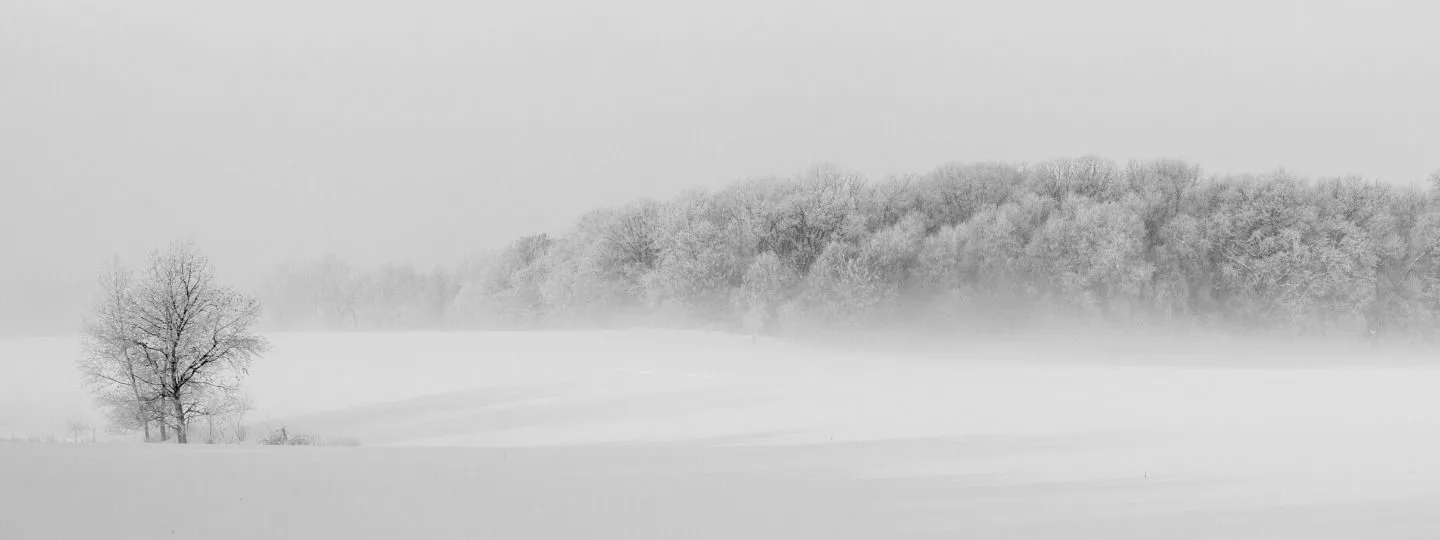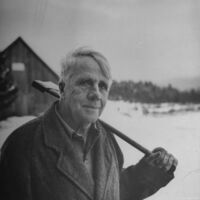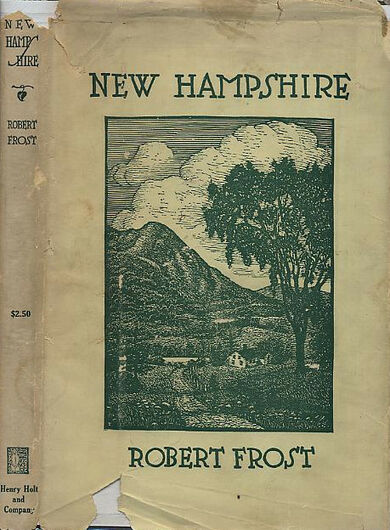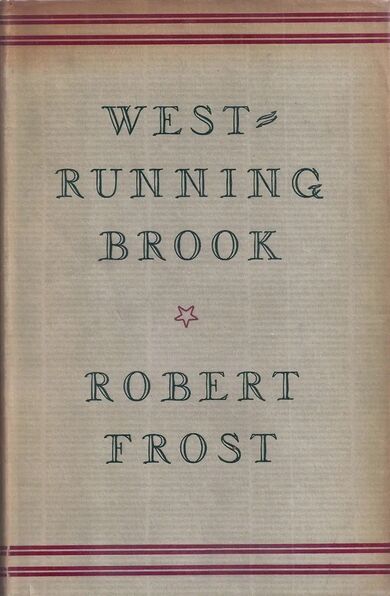
Fire and Ice
By Jeffrey Meyers
The concise, laconic, perfect and perfectly savage "Fire and Ice," the antithesis of the long-winded "New Hampshire," belongs with the apocalyptic "Once by the Pacific." The alternatives in the title represent passion and hatred, two ways of destroying the world. The poem was inspired by a passage in Canto 32 of Dante's Inferno, in which the betrayers of their own kind are plunged, while in a fiery hell, up to their necks in ice: "a lake so bound with ice, / It did not took like water, but like a glass ... right clear / I saw, where sinners are preserved in ice." The last, understated word in Frost's poem, "suffice," clinches the meaning (like "difference" in "The Road Not Taken") by rhyming with the two lines that end in "ice" and enclosing that thematic word within itself
From Robert Frost: A Biography. Copyright © 1996 by Jeffrey Meyers.By Katherine Kearns
Like ice shrieking across a red-hot griddle, his poetry does, indeed, ride on its own melting. One cannot, and Frost has ensured this absolutely with his unstable irony, make a validated choice between the fire and the ice, or between the language, so insistently mundane, and the potent oversound. Fire and ice are, after all, the inextricable complementarities of one apocalyptic vision: that endlessly regenerative cycle of desire and (self) hatred that necessarily brings the productive poet to scourge his own voice as he mocks both the poetic vocation and the state to which poetry - and if poetry then all language - has come. Frost anticipates modernism's lament and, it may be said, prefigures in his dualism its dubious palliative of self-referential irony. The lyric birds and the weary speakers tell us the genuine Frostian wisdom of achieving a commonsensical accommodation with the fallen world, while inciting at another, and ineffable, level a profound disquiet.
From Robert Frost and a Poetics of Appetite. Copyright © 1994 by Cambridge University Press. Reprinted by permission of the author.By Tom Hansen
Harlow Shapley claimed that he inspired Robert Frost to write "Fire and Ice." Shapley, who taught at Harvard for many years, was perhaps the preeminent American astronomer of his time. Although his name was hardly a household word, it was known and respected among the academic scientific community. In an address he gave in 1960, "Science and the Arts," Dr. Shapley told an anecdote about his encounter with Frost a year or two before "Fire and Ice" was published in 1920. Although there is no reason to doubt his account of that encounter, the poem Frost wrote as a result does not say what Shapley thinks it says.
According to Dr. Shapley, he and Frost met at an annual faculty get-together during one of Frost's stints as poet-in-residence at Harvard. Frost sought Shapley out, tugged at his sleeve—figuratively, if not literally—and said something like, "Now, Professor Shapley. You know all about astronomy. Tell me, how is the world going to end?" [1] Taken aback by this unconventional approach, Shapley assumed Frost was joking. The two of them chatted for a few moments, but not about the end of the world. Then they each became involved in conversations with other people and were soon in different parts of the room. But a while later, Frost sought out Shapley again and asked him the same question. "So," said Shapley to his audience in 1960, "I told him that either the earth would be incinerated, or a permanent ice age would gradually annihilate all life on earth." Shapley went on to explain, as he had earlier explained to Frost, why life on earth would eventually be destroyed by fire or ice.
"Imagine my surprise," Shapley said, "when just a year or two later, I ran across this poem." He then read "Fire and Ice" aloud. He saw "Some say" as a reference to himself—specifically to his meeting with Frost at that gathering of Harvard faculty. "This personal anecdote," Shapley concluded, "illustrates one of the many ways in which scientific knowledge can influence the creation of a work of art and also elucidate the meaning of that work of art."
Frost also spent several years as poet-in-residence at the University of Michigan. A recent article by Sally Pobojewski in LSAmagazine, a publication of the university, shows that Shapley's misreading of "Fire and Ice" persists today, at least among some of the scientific members of the academic community. After quoting the poem's first two lines, the article begins, "For a poet, Robert Frost was a pretty good scientist, say astrophysicists Fred Adams and Greg Laughlin. Frost's fire-or-ice scenario neatly sums up two outcomes from their new study of possible future encounters between our solar system and passing stars" (28).
Like Shapley, Pobojewski fails to see that Frost's apparent directness and simplicity frequently mask, as Cleanth Brooks illustrates in Modern Poetry and the Tradition, his reliance on symbol (113, 114, 117). Though Brooks does not specifically mention "Fire and Ice," it is clearly a poem that must be interpreted symbolically. This is not a matter of preference. The poem unequivocally declares that it is not an astronomical speculation about a catastrophe millions of years in the future.
In several of his poems, Frost presents the outer as emblem or echo or distorted mirror image of the inner. The speaker of "Tree at My Window" notes, as he addresses the tree, that the two of them are dreamers—the tree so often "taken and tossed" and he himself so often "taken and swept / And all but lost" (9, 11-12). The poem concludes,
Fate had her imagination about her,
Your head so much concerned with outer,
Mine with inner, weather.
A similar outer-physical/inner-psychological correspondence is in the concluding quatrain of "Desert Places":
Between stars—on stars where no human race is.
I have it in me so much nearer home
To scare myself with my own desert places.
The colloquial "scare" thinly masks the terror of this poem—not the terror that ripples through us when we vividly realize and almost physically apprehend the limitless emptiness of outer space, but the even greater tenor that washes over us when we realize that the ultimate desert places lie within us.
So it is with "Fire and Ice." Outer blatantly symbolizes inner. Fire is directly equated with desire, the kind that kindles antagonism and conflict. Ice is equated with hate. Fire and ice are born in the dark reaches of inner space, in the smoldering, ice-sheathed human heart. However, if the height of art is to conceal the art, then Frost is a consummate artist, because the terror in the poem is so casually understated that it slips by some readers undetected. The understatement is most evident in the fifth and last lines of the poem. "But if it had to perish twice," Frost says, as if the incineration of the world were little more than a passing sickness. "And would suffice," he concludes in a typically unemphatic last line. The use of first-person pronouns in lines 3, 4, and 6 also quietly contributes to the understatement, suggesting that the poem is only an expression of lightly held personal opinion. This deceptive strategy of understatement leads Shapley and Pobojewski to interpret the poem as idle cosm ic speculation rather than an astute diagnosis of the chronic malfunction of the human heart.
Note
(1.) Although I was part of the audience listening to Shapley's address forty years ago, I imperfectly recall Shapley's account of his meeting with Frost. Still, Dr. Shapley made a strong impression, one that lingers yet. Bemused by Frost and viewing him as something of a character, Shapley presented himself as a forthright man of science and common sense, hardheaded but broad-minded. Therefore, the words I attribute to him—and those he attributed to Frost—must be taken as no more than approximations intended to convey the essence of what he said and to suggest something of the spirit in which he said it.
Works Cited
Brooks, Cleanth. Modern Poetry and the Tradition. New York: Oxford UP, 1965.
Frost, Robert. Robert Frost: Poetry and Prose. Ed. Edward C. Lathem and Lawrance Thompson. New York: Holt, 1972.
Pobojewski, Sally. "This Is the Way the World Ends." LSAmagazine 23.1 ( Fall 1999): 28—29.
From The Explicator 59.1 (Fall 2000)By John N. Serio
Most readers of Robert Frost's poem "Fire and Ice" agree with Lawrance Thompson's view that the poem is a marvel of compactness, signaling for Frost "a new style, tone, manner, [and] form" (Years of Triumph 152). Thompson interprets "Fire and Ice" as hinting at the destructive powers of "the heat of love or passion and the cold of hate," sensing that "these two extremes are made so to encompass life as to be a gathering up of all that may exist between them; all that may be swept away by them" (Fire and Ice 122). But a closer look at the poem reveals that in structure, style, and theme "Fire and Ice" is a brilliant, gemlike compression of Dante's Inferno.(1) As such, it presents a much more profound distinction between the two extremes of love and hate. Like Dante, Frost follows Aristotle in condemning hatred as far worse than desire.
At its most obvious, formal level, "Fire and Ice" has nine lines, mirroring Dante's nine circles of hell. Although Frost's poem is not exactly funnel shaped like Dante's hell, it does narrow considerably at the end as Frost literally cuts in half his general pattern of four stresses (iambic tetrameter) to close on two lines having only two stresses each (iambic dimeter). Interestingly, the one line near the opening or top of the poem that contains two stresses, "Some say in ice," evokes the frozen punishment awaiting the worst sinners at the constricted bottom of Dante's hell. In addition, and surprisingly overlooked by most readers, Frost employs a modified terza rima, the rhyme scheme Dante invented for his Divine Comedy: aba, abc, bcb.
But it is at the thematic level that Frost most tellingly follows Dante, for the poem reflects the same system of ethics that Dante employs to classify the sins and punishments of hell. In reading the Inferno, readers are often puzzled by Dante's arrangement, because flatterers, fortunetellers, hypocrites, thieves, even counterfeiters are placed below murderers. The explanation that Dante provides in canto 11 derives from Aristotle: Sins of reason are worse than sins of passion. In the Nicomachean Ethics, Aristotle observes that what distinguishes human beings from other life forms is reason; therefore, human beings must function with reason in order to fulfill their maximum potential, what Aristotle terms arete - excellence or virtue (17). As a Catholic, Dante modifies this principle by adding that reason is God's greatest gift to humankind and, therefore, its perversion or misuse constitutes the worst possible sin: "But since fraud / Is the vice of which man alone is capable, / God loathes it most" (Ciardi 11.24-26).
All the damned know they have committed sin, but those in the upper circles such as the carnal, the gluttons, the hoarders and wasters, the angry and sullen (note the Aristotelian lack of moderation in these categories) let passion sway their reason. Those in middle hell such as the murderers, warmongers, suicides, and homosexuals exercise emotion in alignment with reason: Violent though some of their actions may be, these sinners do what they think. But those in lower hell - the flatterers, hypocrites, thieves, and those who have betrayed family and country - exercise deceit. They use their reason to camouflage their true intent and thus pervert the proper use, according to Dante, of God's most distinctive gift to humans. Those in the ninth circle, the traitors to friends, family, and country, are frozen in ice, a most fitting punishment for their icy hearts. Though logically all the sinners in hell suffer the same consequence - eternal separation from the presence and love of God - those in the lower regions of hell have committed more serious sins and suffer more. In the very pit of hell, excoriated in the three mouths of icebound Satan, lie the arch-betrayers of all time: Brutus, Cassius, and Judas Iscariot.
Frost's "Fire and Ice" contains this same organizational pattern. The understated opening two lines, "Some say the world will end in fire, / Some say in ice," at first seem merely to suggest the biblical and scientific predictions about the end of the world: an apocalyptic holocaust or a new ice age. However, as figurative representations of desire and hatred, fire and ice embody the very system of Aristotelian ethics Dante employs in arranging the Inferno: Sins of reason are worse than sins of passion. Frost associates fire with the senses and places it first or, so to speak, near the top of his poem as the lesser of the two types of sin: "From what I've tasted of desire / I hold with those who favor fire." The verbs are sensuous and although not direct allusions, they recall characters in Dante's upper hell such as the glutton Ciacco the Hog ("tasted"), the adulterous lovers Paolo and Francesca ("hold"), and the hoarders ("favor"). In addition, by aligning the poem's speaker with a group of others ("I hold with those who favor fire"), Frost implies this is a more common and less serious sin.
When Frost speaks of hatred, however, instead of seeing it as an emotion or feeling, like anger, he presents it as a consequence of thought, of conscious choice: "I think I know enough of hate / To say that for destruction ice / Is also great / And would suffice." The emphasis here, as in Dante, is on reason, or better, on the perversion or misuse of reason, because it is employed not for Christian love but for hatred. The intellectual distancing contained in the repetition "I think I know" the change from the present perfect tense, implying a past action ("I've tasted"), to the present tense ("I think I know"), and the utter isolation of the repeated 'T' without any reference to others mark hatred as worse than desire. Frost underscores this by making it the cause of a second death ("But if it had to perish twice") far more terrible by implication than the first. The pun on the word "ice" in "twice" and "suffice" accentuates the bitter coldness of hatred, and the triple repetition of "ice" at the end of the poem recalls Satan's futile efforts to escape - it is the very beating of his wings that causes the river Cocytus in the ninth circle to freeze.
Like Dante, Frost employs a first-person speaker in his poem. In his dramatic narrative, Dante creates a character named Dante to recount his journey. Although the author and narrator are distinct (after all, Dante the author did not hesitate to place characters in hell whom Dante the narrator pities), there are haunting, autobiographical overtones, as if the Inferno served as a warning not only to others but also to the poet himself:
from the straight road and woke to find myself
alone in a dark wood [...]. (Ciardi 1.1-3)
In "Fire and Ice," the force of the lyric "I" similarly contains an autobiographical edge. The deceptively casual, even flippant tone of the persona masks a deeper, understated meaning.
Whether it is a stark admission by Frost of his ambitious and unforgiving nature or an exorcising of the demon - interestingly enough, Frost included "Fire and Ice" as one of the "Grace Notes" in New Hampshire (1923) - we will never know. But by modeling his poem in both structure and theme on Dante's Inferno, Frost has enriched considerably the meaning of his brief lyric.
Note
1. In addition to the internal evidence, there is circumstantial evidence to suggest Frost's familiarity with Dante's Inferno. Frost's personal library, now housed at the Fales Library of New York University, contains four editions of Dante's Divine Comedy. Although the Fletcher translation of 1931 is too late to have been an influence (the poem first appeared in Harper's in December 1920), the other three - two poetic translations by Longfellow, originally published in 1865, and a prose translation by Charles Eliot Norton in 1892, which relied heavily on Longfellow's popular verse translation - could clearly have had an impact. I am grateful to Helice Koffler of the Fales Library for this information.
The torments of hell are first hinted at in canto 3, when Virgil and Dante, after passing through the Gate of Hell, listen to Charon admonish the souls waiting to be ferried across the fiver Acheron. Both Longfellow and Norton use the same words "heat" and "frost" to describe the unexpected antithesis of punishment awaiting the damned below: "'I come to lead you to the other shore, / To the eternal shades in heat and frost'" (Longfellow 3.86-87). Much later, and in what I think is a veiled tribute to Robert Frost, John Ciardi translates these lines as:
into eternal dark, into fire and ice. (3.83-84)
Works Cited
Aristotle. Nicomachean Ethics. Trans. Martin Ostwald. Indianapolis: Bobbs-Merrill Educational Publishing, 1962.
Dante Alighieri. The Divine Comedy of Dante Alighieri. Trans. Jefferson B. Fletcher. New York: Macmillan, 1931.
——-. The Divine Comedy of Dante Alighieri. Trans. Henry Wadsworth Longfellow. Cambridge, Mass.: Riverside, 1895.
——-. The Divine Comedy of Dante Alighieri. Vols. 9-11. Trans. Henry Wadsworth Longfellow. The Complete Writings of Henry Wadsworth Longfellow. 11 volumes. Cambridge, Mass.: Riverside, 1895.
——-.The Divine Comedy of Dante Alighieri. Trans. Charles Eliot Norton. Cambridge, Mass.: Riverside, 1892.
——-. The Inferno. Trans John Ciardi. New York: Mentor, 1954.
Frost, Robert. New Hampshire: A Poem with Notes and Grace Notes. Woodcuts by J. J. Lankes. New York: Henry Holt, 1923.
Thompson, Lawrance. Fire and Ice: The Art and Thought of Robert Frost. New York: Henry Holt, 1942.
——-. Robert Frost: The Years of Triumph, 1915-1938. New York: Holt, 1970.
From The Explicator 57.4 (Summer 1999)





































